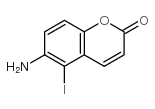INH2BP

INH2BP structure
|
Common Name | INH2BP | ||
|---|---|---|---|---|
| CAS Number | 137881-27-7 | Molecular Weight | 287.05400 | |
| Density | 2.029g/cm3 | Boiling Point | 437.6ºC at 760mmHg | |
| Molecular Formula | C9H6INO2 | Melting Point | N/A | |
| MSDS | Chinese USA | Flash Point | 218.4ºC | |
| Symbol |

GHS07 |
Signal Word | Warning | |
|
The Protective Effect of INH2BP, a Novel PARP Inhibitor 5-Iodo-6-Amino-1,2-Benzopyrone, Against Hydrogen Peroxide-Induced Apoptosis Through ERK and p38 MAPK in H9c2 Cells.
Pharmacology 96 , 259-70, (2015) INH2BP (5-iodo-6-amino-1,2-benzopyrone), a poly-ADP ribose polymerase inhibitor, has been shown to possess anti-cancer, anti-viral, and anti-inflammation properties. The aim of this study was to investigate the protective effect of INH2BP against oxidative st... |
|
|
4-Hydroxynonenal induces apoptosis in human osteoarthritic chondrocytes: the protective role of glutathione-S-transferase.
Arthritis. Res. Ther. 10 , R107, (2008) 4-Hydroxynonenal (HNE) is one of the most abundant and reactive aldehydes of lipid peroxidation products and exerts various effects on intracellular and extracellular signalling cascades. We have previously shown that HNE at low concentrations could be consid... |
|
|
Dichloroacetate enhances apoptotic cell death via oxidative damage and attenuates lactate production in metformin-treated breast cancer cells.
Breast Cancer Res. Treat. 147(3) , 539-50, (2014) The unique metabolism of breast cancer cells provides interest in exploiting this phenomenon therapeutically. Metformin, a promising breast cancer therapeutic, targets complex I of the electron transport chain leading to an accumulation of reactive oxygen spe... |
|
|
Inhibition of poly (ADP-ribose) synthetase by gene disruption or inhibition with 5-iodo-6-amino-1,2-benzopyrone protects mice from multiple-low-dose-streptozotocin-induced diabetes.
Br. J. Pharmacol. 133(6) , 909-19, (2001) Activation of poly(ADP-ribose) synthetase (PARS, also termed polyADP-ribose polymerase or PARP) has been proposed as a major mechanism contributing to beta-cell destruction in type I diabetes. In the present study, we have investigated the role of PARS in med... |
|
|
Protection against peroxynitrite-induced fibroblast injury and arthritis development by inhibition of poly(ADP-ribose) synthase.
Proc. Natl. Acad. Sci. U. S. A. 95(7) , 3867-72, (1998) Peroxynitrite, a cytotoxic oxidant formed from nitric oxide (NO) and superoxide, induces DNA strand breakage, which activates the nuclear enzyme poly(ADP-ribose) synthase (PARS; EC 2.4.2.30). The cellular function of PARS was determined in fibroblast lines fr... |
|
|
Intra-mitochondrial poly(ADP-ribosylation) contributes to NAD+ depletion and cell death induced by oxidative stress.
J. Biol. Chem. 278(20) , 18426-33, (2003) Poly(ADP-ribosylation), primarily via poly(ADP-ribose) polymerase-1 (PARP-1), is a pluripotent cellular process important for maintenance of genomic integrity and RNA transcription in cells. However, during conditions of oxidative stress and energy depletion,... |
|
|
Lipopolysaccharide-induced enterocyte-derived nitric oxide induces intestinal monolayer permeability in an autocrine fashion.
Shock 17(3) , 180-4, (2002) Studies indicate that endotoxin (LPS) causes intestinal injury, increases inducible nitric oxide synthase (iNOS) activity, leads to increased NO production, and promotes bacterial translocation (BT). To investigate the mechanism by which LPS causes gut injury... |
|
|
A dual role for poly-ADP-ribosylation in spatial memory acquisition after traumatic brain injury in mice involving NAD+ depletion and ribosylation of 14-3-3gamma.
J. Neurochem. 85(3) , 697-708, (2003) Poly(ADP-ribose) polymerase-1 (PARP-1) is a homeostatic enzyme that paradoxically contributes to disturbances in spatial memory acquisition after traumatic brain injury (TBI) in transgenic mice, thought to be related to depletion of its substrate nicotinamide... |
|
|
Protective effects of 5-iodo-6-amino-1,2-benzopyrone, an inhibitor of poly(ADP-ribose) synthetase against peroxynitrite-induced glial damage and stroke development.
Eur. J. Pharmacol. 351(3) , 377-82, (1998) Peroxynitrite triggers DNA single-strand breakage, which activates the nuclear enzyme poly(ADP-ribose) synthetase (PARS). Activation of PARS depletes its substrate, NAD+, slowing the rate of glycolysis, electron transport, and ATP formation, resulting in cell... |
|
|
Role of poly(ADP-ribose) synthetase activation in the development of experimental allergic encephalomyelitis.
J. Neuroimmunol. 117(1-2) , 78-86, (2001) Peroxynitrite formation has been demonstrated during experimental allergic encephalomyelitis (EAE). Furthermore, peroxynitrite has been identified as an activator of poly(ADP-ribose) synthetase (PARS), an enzyme implicated in neurotoxicity. In the current stu... |